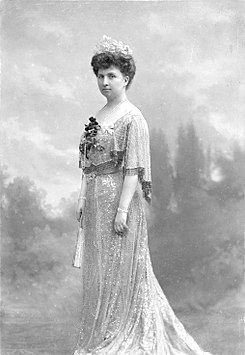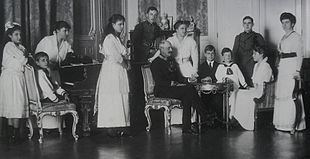Name Infanta of | ||
 | ||
Issue Archduchess Dolores of AustriaArchduchess Immaculata of AustriaArchduchess Margaretha of AustriaArchduke Rainer of AustriaArchduke Leopold of AustriaArchduchess Maria Antonia of AustriaArchduke Anton of AustriaArchduchess Assunta of AustriaArchduke Franz Josef of AustriaArchduke Karl Pius of Austria House House of BourbonHouse of Habsburg-Lorraine Father Infante Carlos, Duke of Madrid Children Archduke Karl Pius of Austria, Prince of Tuscany Parents Princess Margherita of Bourbon-Parma, Carlos, Duke of Madrid Grandchildren Archduke Stefan of Austria Similar People Carlos - Duke of Madrid, Archduke Anton of Austria, Berthe de Rohan, Princess Ileana of Romania, Archduke Stefan of Austria | ||
Infanta Blanca of Spain (7 September 1868 – 25 October 1949) was the eldest child of Carlos, Duke of Madrid, Carlist claimant to the throne of Spain and his wife Princess Margherita of Bourbon-Parma. Blanca was a member of the House of Bourbon and - according to the Carlists - an Infanta of Spain by birth. In 1889 she married Archduke Leopold Salvator of Austria. The couple had ten children. The family left Austria after the end of the Monarchy and finally settled in Barcelona. When the male line of Blanca's family died out at the death of her uncle, Alfonso Carlos, Duke of San Jaime, some of the Carlists recognized her as the legitimate heiress to the Spanish throne.
Contents

Early life
Infanta Blanca of Spain was born in Graz, Styria, Austria-Hungary, the eldest child of Carlos, Duke of Madrid, the Carlist claimant to the throne of Spain under the name Carlos VII and of his wife Princess Margherita of Bourbon-Parma. At the time of her birth, her parents where living in Styria in order to be close to her maternal great-grand mother, the Duchess of Berry. Her father left the same day to Paris where he learnt of the revolution that deposed Queen Isabella II of Spain. Don Carlos was joined in Paris by his wife and daughter and from there they moved to Switzerland. Blanca's childhood was marked by the third Carlist War (1872–1876) in which her father tried, unsuccessfully, to gain the throne of Spain by force. To be near the Spanish border Margherita moved with her children to Pau. For a time in 1875, Blanca lived in Elizondo, Navarre at the court established by her father. After the war ended badly, crushing Don Carlos hopes of taking the throne of Spain,the family lived mostly in the Parisian district of Passy. In 1881 they were expelled from France due to Carlos's political activities. By then Blanca's parents drifted apart. Her father went to live in his palace in Venice, while her mother retired to Tenuata Reale, a estate in Viareggio, Italy inherited in 1879 from Blanca's great-grandmother, Duchess Maria Teresa of Parma. Blanca and her siblings divided their time between their parents. In 1881 Blanca and her sisters entered the Sacre Coeur, a catholic school run by nuns in Florence. Blanca played the mandolin and was very fond of horses. In 1883, upon finishing her schooling, she visited Spain incognito with her parents permission. At her return she was officially introduced to the court in Vienna.
Marriage and issue
At the court of the Habsburgs, Blanca, the eldest and the best looking of four sisters, attracted the attention of Archduke Leopold Salvator of Austria, second child and eldest son of Archduke Karl Salvator of Austria and his wife Princess Maria Immaculata of Bourbon-Two Sicilies. They were married, on 24 October 1889 at Schloss Frohsdorf in Lanzenkirchen, Lower Austria, Austria. The newlywed settled in Lemberg, Galicia, then in Agram, Croatia and finally in Vienna, following Archduke leopold Salvator's military appointments.
Blanca and Leopold Salvator main residence was the Palais Toskana in Vienna, they also owned Schloss Wilhelminenberg and a rural estate near Viareggio, which Archduchess Blanca inherited from her mother. The marriage was happy and produced ten children:
Later life
Until World War I , Blanca and her large family had a pleasant uncomplicated existence moving according to the seasons among their various residences. During World War I her husband took on of the provision of food for the Austrian Army in the front and was inspector general of Artillery until 1918. Blanca's two eldest sons also joined the Austrian army fighting in the Italian front, while her daughters Immaculata and Margarita worked for the Austrian red cross. After the war and proclaimed the Republic, the properties of the imperial family were Confiscated by the new Austrian government. Wilheminenberg was converted into a military hospital and then sold to a Swiss banker. With the lost of their wealth, they had to live in exile with meager means. The family could neither live in France nor in Italy, countries that had been Austria's enemies during the war.
Blanca was forced to ask permission to live in Barcelona to her cousin Alphonso XIII of Spain, who belonged to the rival branch of the Spanish Bourbons. Alphonso XIII allowed them to come to Spain on condition that they did not support the claims to the Spanish throne of Blanca's brother Jaime, Duke of Madrid. In 1922 Blanca was recognized as a Spaniard. The exiled family had to live modestly in a house in Barcelona. The fall of Alphonso XIII and the proclamation of the Second Spanish Republic in April 1931 did not affect directly their circumstances. However five months later, Blanca's husband died during a trip to Austria while trying to recover some of their lost properties. Blanca was left under strained economical means, living from vineyards at La Tenuata Reale at Viareggio and from a small rent provided by the Carlist party of Catalonia. Three of her children were still living with her: Dolores, Margaretha and Karl. The convulsed political situation in Spain made them returned to Austria.
The family was able to rent three rooms at their former residence in Vienna, the Palais Toskana. In March 1938 Hitler annexed Austria and Blanca with her children Dolores and Karl moved to her property in Viareggio. In later years, Blanca and her youngest sons Karl Pius and Franz Josef became involved in various Carlist disputes and claims. She died, aged 81, in Viareggio, Tuscany, Italy.
